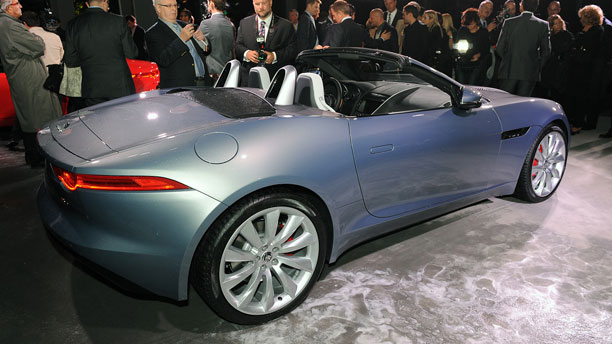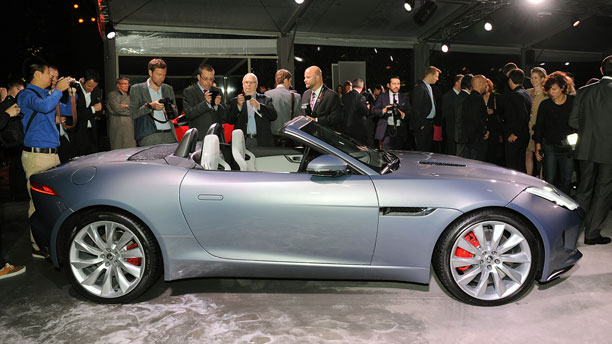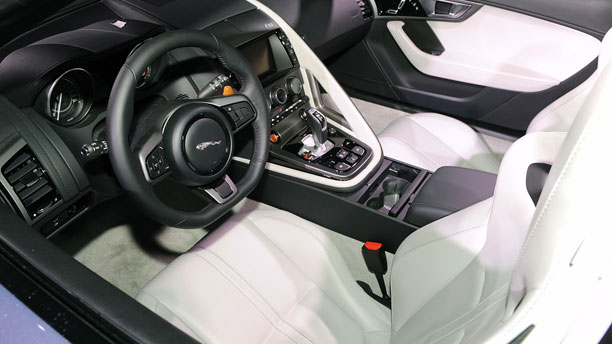The New York Yankees have Lou Gehrig. Republicans have Ronald Reagan. And Jaguar has its E-Type.
Every brand needs an icon to point to, a stake in the ground, an example of its essence that epitomizes everything the brand means and stands for, and serves as a reminder when the current caretakers lose the plot of the brand.
In the case of British sports-car icon Jaguar, the E-Type, built between 1961 and 1974, cemented Jag's place in the global marketplace as a car for people who equate driving and design with sex and fun, not practicality and durability. It was, quite simply, the opposite of, say, today's Toyota Camry or Honda Civic. The Daily Telegraph in London in 2008, proclaimed the E-Type to be at the top of a list of the "100 most beautiful cars" of all time based on reader votes. And no less an arbiter of automotive design than Enzo Ferrari declared the car the "most beautiful car ever made." High praise from a fierce rival.
No good comes from an automaker trying to recreate past glory in a single model: witness the 2000 revival of Ford Thunderbird or the Chevy HHR. So, Jaguar today unveiled the F-Type, a car that is the spiritual successor to the iconic sports car without trying to knock it off in a ham-fisted way. This is no retro car.
The first change from E-Type to F-Type that will be evident to those lusting after the E-Type at classic car shows is the shorter front end of the new car. The elongated front end on the E-Type just isn't possible today, explained Jaguar studio director Wayne Burgess, because of all the various safety standards that have to be met. Driver comfort also dictates new proportions. "As wonderful as the E-Type is, I am just 6-foot and one-inch tall, and when i sit in one, my head extends above the windscreen and I get bugs in my face," said Burgess. "Besides the proportions of the F-Type makes for extremely balanced handling, which buyers will appreciate."

Regardless of the length of the front of the car, it the F-Type is a beautiful car, and one that Jag executives hope will put it back on the map with well-heeled buyers when it goes on sale next year. "It is the most anticipated Jaguar in the history of the company," said Jaguar global chief Adrian Hallmark.
What is the new Jaguar F-Type under the skin? It is an all-all-aluminum two-seater that is available in three trim levels--F-Type, F-Type S and F-Type V8 S. The entry-model will offer a supercharged 3.0-liter V6 with 340 horsepower and 332 pound-feet of torque. Then you can step up to a supercharged 3.0-liter V6 (380 hp / 339 lb-ft.), or a supercharged 5.0-liter V8 (495 hp / 460 lb-ft). There is no manual transmission offered--not off the bat at least--so shift livers will have to be content with an eight-speed automatic with paddle-shifter.
How fast? Jag says it will handle 0-60 in 4.2 seconds, with a speed limiter that keeps you grounded at 186 mph. The V6 S does races at 4.8 seconds and closes down at 171 mph, while the 'base' F-Type still runs to 60 in 5.1 seconds and hits a 161-mph limiter.

The aluminium frame helped keep weight down to a respectable 3,520 pounds, and the structure is said to be rock solid and taut, though we have not driven it yet. Without occupants, the weight distribution is 52% to the front and 48% to the rear.
The interior of the Jaguar F-type has some interesting bits and bobs influenced by fighter aircraft. Believe it or not, there is a shift control just to the side of the gear shifter that will adjust the drive dynamics of the car that was lifted from the Eurofighter Typhoon military plane. Jag designers studied and found the plane had just such a shifter for "Eco," "Combat," and "Cruise." A bank of switchgear in the dash was taken from Apache helicopters.
The rear of the car has four exhaust pipes for the V8. For the VG, there are two in the center. The horizontal taillights are directly inspired by those of the original E-Type. The tail also features a deployable rear spoiler, which helps the car maintain a clean looking, elegant design when standing still.

Why is this car such a big deal to Jaguar? To the automotive world? For Jaguar, it is a car the company hopes will awaken interest in the British brand. Not that the existing Jags--the XF, XJ and XK aren't respectable vehicles. But there has been a lack of oomph on the Jaguar side of the company, which only sells about 40,000 cars a year worldwide, while Land Rover sells North of 176,000.
In case you were sleeping, Jaguar and Land Rover are operated as a single company these days and owned by Indian automaker and conglomerate Tata.
While there were doubters about Tata being a good steward of the two British brands, the company has been a better parent than previous owner, Ford Motor Co. Where Ford was trying to manage the perennially money-losing Brit brands amidst its own financial meltdown, Tata is utterly focused on making these brands a bigger success on the world stage.
Not only did the company fund the F-Type project, but it invested huge money to offer all-wheel-drive systems in the 2013 XF and XJ as the rear-drive only configuration among luxury sedans is disappearing in the U.S. and was making the cars uncompetitive.
Those moves took care of the rational, practical side of Jaguar. The introduction of the F-Type is meant to make people actually dream a little of owning a Jag again.
CHECK OUT MORE PHOTOS AT AUTOBLOG!
Related Video:
Every brand needs an icon to point to, a stake in the ground, an example of its essence that epitomizes everything the brand means and stands for, and serves as a reminder when the current caretakers lose the plot of the brand.
In the case of British sports-car icon Jaguar, the E-Type, built between 1961 and 1974, cemented Jag's place in the global marketplace as a car for people who equate driving and design with sex and fun, not practicality and durability. It was, quite simply, the opposite of, say, today's Toyota Camry or Honda Civic. The Daily Telegraph in London in 2008, proclaimed the E-Type to be at the top of a list of the "100 most beautiful cars" of all time based on reader votes. And no less an arbiter of automotive design than Enzo Ferrari declared the car the "most beautiful car ever made." High praise from a fierce rival.
No good comes from an automaker trying to recreate past glory in a single model: witness the 2000 revival of Ford Thunderbird or the Chevy HHR. So, Jaguar today unveiled the F-Type, a car that is the spiritual successor to the iconic sports car without trying to knock it off in a ham-fisted way. This is no retro car.
The first change from E-Type to F-Type that will be evident to those lusting after the E-Type at classic car shows is the shorter front end of the new car. The elongated front end on the E-Type just isn't possible today, explained Jaguar studio director Wayne Burgess, because of all the various safety standards that have to be met. Driver comfort also dictates new proportions. "As wonderful as the E-Type is, I am just 6-foot and one-inch tall, and when i sit in one, my head extends above the windscreen and I get bugs in my face," said Burgess. "Besides the proportions of the F-Type makes for extremely balanced handling, which buyers will appreciate."

Regardless of the length of the front of the car, it the F-Type is a beautiful car, and one that Jag executives hope will put it back on the map with well-heeled buyers when it goes on sale next year. "It is the most anticipated Jaguar in the history of the company," said Jaguar global chief Adrian Hallmark.
What is the new Jaguar F-Type under the skin? It is an all-all-aluminum two-seater that is available in three trim levels--F-Type, F-Type S and F-Type V8 S. The entry-model will offer a supercharged 3.0-liter V6 with 340 horsepower and 332 pound-feet of torque. Then you can step up to a supercharged 3.0-liter V6 (380 hp / 339 lb-ft.), or a supercharged 5.0-liter V8 (495 hp / 460 lb-ft). There is no manual transmission offered--not off the bat at least--so shift livers will have to be content with an eight-speed automatic with paddle-shifter.
How fast? Jag says it will handle 0-60 in 4.2 seconds, with a speed limiter that keeps you grounded at 186 mph. The V6 S does races at 4.8 seconds and closes down at 171 mph, while the 'base' F-Type still runs to 60 in 5.1 seconds and hits a 161-mph limiter.

The aluminium frame helped keep weight down to a respectable 3,520 pounds, and the structure is said to be rock solid and taut, though we have not driven it yet. Without occupants, the weight distribution is 52% to the front and 48% to the rear.
The interior of the Jaguar F-type has some interesting bits and bobs influenced by fighter aircraft. Believe it or not, there is a shift control just to the side of the gear shifter that will adjust the drive dynamics of the car that was lifted from the Eurofighter Typhoon military plane. Jag designers studied and found the plane had just such a shifter for "Eco," "Combat," and "Cruise." A bank of switchgear in the dash was taken from Apache helicopters.
The rear of the car has four exhaust pipes for the V8. For the VG, there are two in the center. The horizontal taillights are directly inspired by those of the original E-Type. The tail also features a deployable rear spoiler, which helps the car maintain a clean looking, elegant design when standing still.

Why is this car such a big deal to Jaguar? To the automotive world? For Jaguar, it is a car the company hopes will awaken interest in the British brand. Not that the existing Jags--the XF, XJ and XK aren't respectable vehicles. But there has been a lack of oomph on the Jaguar side of the company, which only sells about 40,000 cars a year worldwide, while Land Rover sells North of 176,000.
In case you were sleeping, Jaguar and Land Rover are operated as a single company these days and owned by Indian automaker and conglomerate Tata.
While there were doubters about Tata being a good steward of the two British brands, the company has been a better parent than previous owner, Ford Motor Co. Where Ford was trying to manage the perennially money-losing Brit brands amidst its own financial meltdown, Tata is utterly focused on making these brands a bigger success on the world stage.
Not only did the company fund the F-Type project, but it invested huge money to offer all-wheel-drive systems in the 2013 XF and XJ as the rear-drive only configuration among luxury sedans is disappearing in the U.S. and was making the cars uncompetitive.
Those moves took care of the rational, practical side of Jaguar. The introduction of the F-Type is meant to make people actually dream a little of owning a Jag again.
CHECK OUT MORE PHOTOS AT AUTOBLOG!
Related Video:


Sign in to post
Please sign in to leave a comment.
Continue